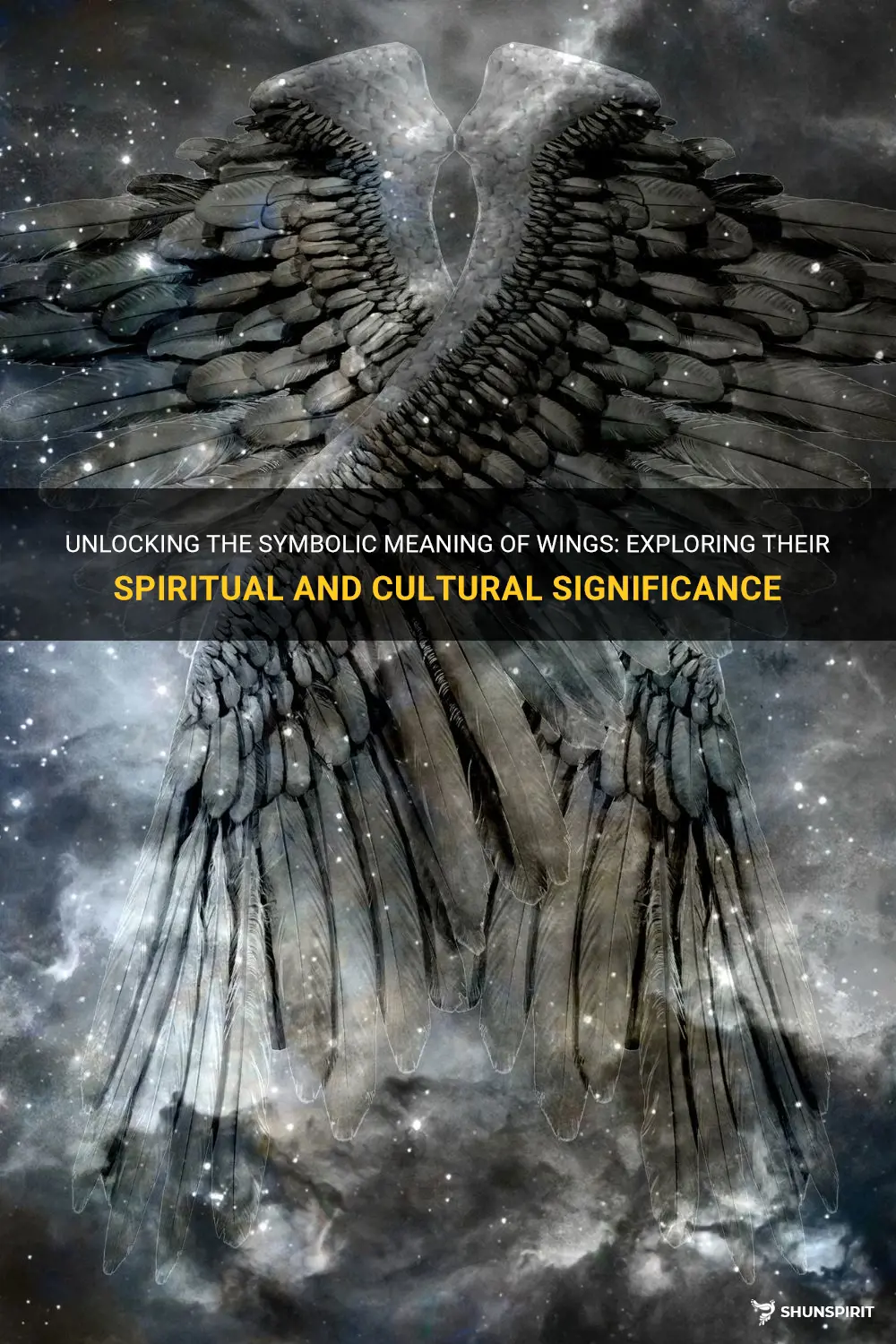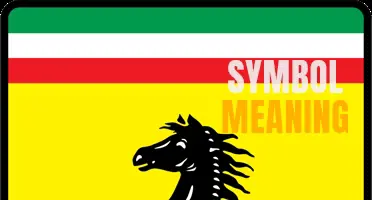
Wings, whether in the realm of myth or reality, hold a captivating and universal allure. Symbolic of freedom, transcendence, and power, wings have long enthralled the human imagination. From the mythological figures such as angels and Pegasus, to the graceful flight of birds and the awe-inspiring wonder of insects, wings symbolize the ability to soar above earthly limitations. They are a powerful expression of our desire to break free from the chains of our mortal existence and reach for the heavens. Join me as we explore the deep and intricate symbolism behind these ethereal appendages and unlock the secrets they hold.
What You'll Learn
- What is the symbolic meaning of wings in different cultures and religions?
- How do wings symbolize freedom and liberation in various artistic representations?
- What are some common representations of wings in mythology and folklore?
- How do wings symbolize transcendence and spiritual growth in spiritual and metaphysical beliefs?
- In what ways do wings symbolize protection and guidance in various spiritual traditions?

What is the symbolic meaning of wings in different cultures and religions?
Wings have held deep symbolic meaning for humans throughout history, appearing in various cultures and religions. Whether depicted on a mythical creature or used in religious art, wings often represent power, freedom, protection, and spirituality. Let's explore the symbolic meaning of wings in different cultures and religions.
In ancient Greek mythology, wings were associated with the gods and goddesses. The most famous example is the winged god Hermes, who was known as the messenger of the gods. His winged sandals and a winged helmet enabled him to travel swiftly between the mortal world and Mount Olympus. The wings symbolized his nimbleness, agility, and divine status.
In Christian symbolism, wings are often associated with angels. Angels are believed to be celestial beings who serve as messengers of God and protectors of humans. Angels are commonly depicted with wings, which represent their ability to move between heaven and earth. Wings in Christian art symbolize divinity, purity, and the heavenly realm.
In Native American culture, wings hold spiritual significance, particularly among tribes such as the Lakota and the Hopi. For the Lakota, the eagle's wings symbolize the connection between humans and the spiritual world. Eagle feathers are considered sacred and are used in ceremonies to offer prayers and seek protection and guidance. Similarly, in Hopi mythology, the Katsinas (spirit beings) are depicted with wings, symbolizing their ability to fly between the mortal world and the spirit realm.
In Hinduism, wings are associated with Garuda, a divine eagle-like creature. Garuda is the vehicle of Lord Vishnu, one of the principal deities in Hinduism. The wings of Garuda represent his ability to transcend physical limitations and reach higher spiritual realms. Garuda is believed to be the king of birds and a symbol of power and protection.
In ancient Egyptian mythology, wings were often associated with the goddess Isis, who was regarded as the protector of the deceased. Isis was often depicted with wings spread out, representing her ability to fly and protect the souls of the dead. In this context, wings symbolize the journey of the soul, the afterlife, and the protection provided by the goddess.
Across different cultures and religions, wings symbolize a connection between the physical and spiritual realms. They represent freedom, transcendence, and protection. Whether depicted on gods, angels, or mythical creatures, wings serve as a reminder of the transcendent and divine nature of existence.
In conclusion, the symbolic meaning of wings is deep-rooted in various cultures and religions. From Greek mythology to Native American traditions, wings represent power, freedom, protection, and spirituality. The wings of Hermes, angels in Christian art, Garuda in Hinduism, and Isis in ancient Egyptian mythology all serve to connect humans with the divine and signify the ability to transcend physical limitations. The universal symbolism of wings reflects the shared human desire for spiritual enlightenment and protection.
Unraveling the Mysteries of the Merkaba Symbol: Sacred Geometry and Spiritual Meaning
You may want to see also

How do wings symbolize freedom and liberation in various artistic representations?
Wings have long been a symbol of freedom and liberation in various artistic representations. They represent the ability to soar above constraints and limitations, to break free from earthly bounds and reach new heights. From ancient civilizations to modern art, wings have held a powerful significance and have been depicted in various forms.
In ancient mythology, wings were often associated with gods, goddesses, and other divine beings. One of the most famous examples is the winged god Hermes from Greek mythology. Hermes, also known as Mercury in Roman mythology, was the messenger of the gods, and his winged sandals and winged helmet enabled him to travel swiftly between the mortal world and Mount Olympus. His wings symbolized his freedom to traverse great distances and deliver messages from the gods.
In Renaissance art, wings were commonly used to represent angels. Angels were often depicted with large, majestic wings that conveyed a sense of heavenly beauty and grace. These wings symbolized the angel's ability to transcend earthly limitations and serve as intermediaries between heaven and earth. Artists such as Michelangelo and Raphael frequently incorporated wings in their angelic depictions, portraying them with angelic wings that exuded a sense of divine freedom.
In addition to their associations with divinity, wings have also been used as a symbol of personal freedom and liberation. In the 20th century, wings became a popular motif in art movements such as Art Nouveau and Art Deco. Artists embraced the idea of freedom from societal norms and restrictions, and wings became a visual representation of this desire for liberation. The wings in these art movements often took on a more abstract form, appearing as stylized and flowing shapes that embodied the notion of freedom.
Wings have also found a prominent place in modern art, where they continue to symbolize freedom and liberation. From graffiti artists to contemporary painters, wings are used to express a sense of breaking free from constraints and embracing individuality. Street artists often create murals featuring wings, inviting viewers to imagine themselves ascending above their surroundings and embracing their own unique path.
In conclusion, wings symbolize freedom and liberation in various artistic representations. Whether associated with gods and angels or used to represent personal freedom, wings convey a sense of transcending limits and reaching new heights. From ancient mythology to modern art, the symbolism of wings continues to inspire and captivate viewers, reminding them of their own innate capacity to soar above constraints and embrace their own unique sense of freedom.
The Meaning Behind the Moon Symbol on Instagram
You may want to see also

What are some common representations of wings in mythology and folklore?
Wings are a fascinating and mystical symbol that has been depicted in mythology and folklore for centuries. They represent a sense of freedom, power, and spirituality. Various cultures and civilizations have associated wings with different creatures and gods, each carrying their unique significance. Let's explore some common representations of wings in mythology and folklore.
Angels:
One of the most well-known representations of wings is in the form of angels. Angels are often depicted with large, feathery wings that allow them to fly between heaven and earth. In many traditions, wings symbolize divinity, purity, and protection. Angels are believed to be messengers of God or intermediaries between the divine and human realms.
Birds:
Birds and their wings have been a symbol of freedom and transcendence across various cultures. In Greek mythology, the winged horse Pegasus was a divine creature capable of flight. The Native American Hopi tribe believes that birds carry messages between the physical and spiritual worlds. In many folklore stories, birds with wings represent the ability to rise above earthly constraints and connect with the divine.
Dragons:
In many Eastern cultures, dragons are depicted with wings. These majestic creatures are known for their power, wisdom, and often represent the primordial forces of nature. Dragon wings symbolize strength, protection, and the transformation of energy. Chinese dragon mythology often portrays dragons as protectors of the heavens and earth.
Sphinxes:
The Sphinx, a creature with the body of a lion and wings of an eagle, is a significant symbol in ancient Egyptian mythology. Sphinxes were often depicted as guardians or sentinels of sacred places. The wings represent the ability to soar above the mortal world and possess supernatural powers.
Harpies:
Harpies are winged creatures from Greek mythology that were believed to be the personification of storm winds. They were depicted as bird-like creatures with women's faces, often associated with punishment and retribution. Harpies' wings signify their ability to bring swift, destructive winds and act as agents of divine justice.
Valkyries:
In Norse mythology, Valkyries were female figures closely associated with battle and warfare. These powerful beings would select warriors fallen in battle and bring them to the afterlife. Valkyries were often depicted with wings, symbolizing their role as choosers of the slain and their connection to the heavens.
Fairies:
In folklore and fairy tales, fairies are often depicted with wings. These enchanting creatures are known for their magical abilities and connection to nature. Fairy wings symbolize their ability to move effortlessly between the human world and the realm of magic. Often portrayed as delicate and elegant, fairy wings represent grace, beauty, and ethereal qualities.
In conclusion, wings hold significant symbolism in mythology and folklore. From angels to birds, dragons to sphinxes, winged creatures are associated with divinity, freedom, and a connection to the spiritual realm. The representation of wings in various myths and stories may vary, but they all convey a sense of power, transcendence, and the ability to rise above earthly limitations.
Exploring the Rich Symbolism and Meanings Behind Puerto Rican Culture
You may want to see also

How do wings symbolize transcendence and spiritual growth in spiritual and metaphysical beliefs?
Wings have long been used as symbols of transcendence and spiritual growth in various spiritual and metaphysical beliefs. These beliefs often associate wings with higher consciousness, enlightenment, and the ability to rise above earthly limitations. Whether depicted in art, mythology, or religious texts, wings serve as a powerful metaphor for the human journey towards spiritual liberation and self-realization.
In many religious traditions, wings are often associated with divine beings and angels. They are seen as a representation of their celestial nature and their ability to move freely between the realms of heaven and earth. The wings of angels are considered to be a symbol of divine grace, guiding individuals towards a higher understanding and connection with the divine.
In metaphysical beliefs, wings are thought to be connected to the concept of ascension. Ascension refers to the process of raising one's vibrational frequency and expanding one's consciousness, ultimately leading to spiritual enlightenment. Wings are seen as a visual representation of this ascension process, signifying the ability to reach higher states of awareness and connect with the divine.
The symbolism of wings in spiritual and metaphysical beliefs also extends to the concept of personal growth and transformation. Wings are often associated with the idea of liberation and freedom from the constraints of the ego and the physical world. They represent the ability to transcend personal limitations, beliefs, and fears, and to embrace one's true essence and potential.
Furthermore, wings can also be seen as a metaphor for spiritual guidance and protection. Many spiritual traditions believe that individuals are guided and protected by higher beings or guardian angels. Wings are seen as a symbol of this guidance, reminding individuals that they are always supported and guided on their spiritual path.
The concept of wings and spiritual growth can also be understood in terms of the chakra system, which is a key component of many spiritual and metaphysical practices. The upper chakras, such as the crown and third eye chakras, are associated with higher levels of consciousness and spiritual connection. These chakras are often depicted as wings or lotus flowers unfolding, symbolizing the expansion of awareness and the opening of spiritual perception.
In conclusion, wings symbolize transcendence and spiritual growth in spiritual and metaphysical beliefs by representing the journey towards higher consciousness, enlightenment, and connection with the divine. They serve as a metaphor for personal growth, liberation, and the ability to rise above earthly limitations. Whether depicted in art, mythology, or religious texts, wings are a powerful symbol that reminds individuals of their spiritual nature and their potential for spiritual transformation.
Understanding Ford Escape Dashboard Symbols and Their Meanings
You may want to see also

In what ways do wings symbolize protection and guidance in various spiritual traditions?
Wings have long been a symbol of protection and guidance in various spiritual traditions. Across different cultures, wings are often associated with divine beings and are believed to carry powerful energy. They represent the ability to transcend earthly limitations and connect with higher realms. Let's explore some ways wings are symbolized in different spiritual traditions:
- Christianity: In Christian symbolism, wings are often associated with angels. Angels are believed to be messengers of God and are depicted with wings to represent their ability to fly between heaven and earth. They are seen as protectors and guides, offering divine assistance and protection to humans. The image of angels with wings in Christian art and literature embodies the idea of divine support and guidance.
- Ancient Egypt: In ancient Egyptian mythology, the goddess Ma'at, who represented truth, justice, and cosmic balance, is often depicted with wings. Her wings symbolize her ability to keep order and maintain balance in the universe. The wings of Ma'at represent her protective presence, ensuring that the world remains harmonious and just.
- Native American traditions: In many Native American cultures, wings symbolize spiritual protection and guidance. For example, the symbol of the eagle's wing is considered sacred and is believed to provide strength and protection. Native Americans believe that the eagle flies closest to the sun and carries prayers and messages to the Great Spirit. The wings of the eagle are seen as protective shields that guard and guide those who seek spiritual connection.
- Hinduism: In Hinduism, wings are often associated with Garuda, a divine eagle-like creature. Garuda is considered the king of birds and the mount of Lord Vishnu. His wings symbolize his ability to swiftly move across the realms and carry divine messages. Garuda is believed to provide protection from evil forces and guide spiritual seekers on their paths.
- Greek mythology: In Greek mythology, wings symbolize the power of flight and the ability to transcend earthly boundaries. The god Hermes, often depicted with wings on his sandals and helmet, is the messenger of the gods. His wings represent his swiftness and ability to travel between the mortal and immortal realms. Hermes' wings also symbolize his role as a guide, leading souls to the afterlife, and providing protection during their journey.
In conclusion, wings symbolize protection and guidance in various spiritual traditions. They represent divine presence, the ability to transcend earthly limitations, and connect with higher realms. Whether associated with angels, goddesses, eagles, or gods, wings signify spiritual support, strength, and direction. They serve as a reminder that we are never alone and that there are powerful forces guiding and protecting us on our spiritual journeys.
Understanding the Symbols on Your AC Remote: Decoding Their Meanings
You may want to see also
Frequently asked questions
Wings have long been associated with freedom, spirituality, and transcendence. They are often seen as a symbol of liberation from earthly constraints and the ability to soar above adversity. In many cultures and belief systems, wings are also seen as a representation of the divine or higher power.
In mythology, wings are often associated with gods, goddesses, and mythological creatures. They are seen as a symbol of their celestial nature and divine power. For example, in Greek mythology, the god Hermes is depicted with winged sandals and a winged cap, symbolizing his ability to travel swiftly and communicate between the mortal and divine realms.
Yes, wings are often seen as a symbol of protection. In many cultures, angels are depicted with wings, and they are believed to provide guidance, comfort, and protection to those in need. Wings can also symbolize guardian spirits or beings that watch over and shield individuals from harm.
Yes, wings can be seen as a symbol of personal growth and transformation. Just as a caterpillar transforms into a butterfly, wings can represent the journey of self-discovery, overcoming obstacles, and evolving into a higher state of being. They symbolize the ability to break free from limitations and embrace one's true potential.







